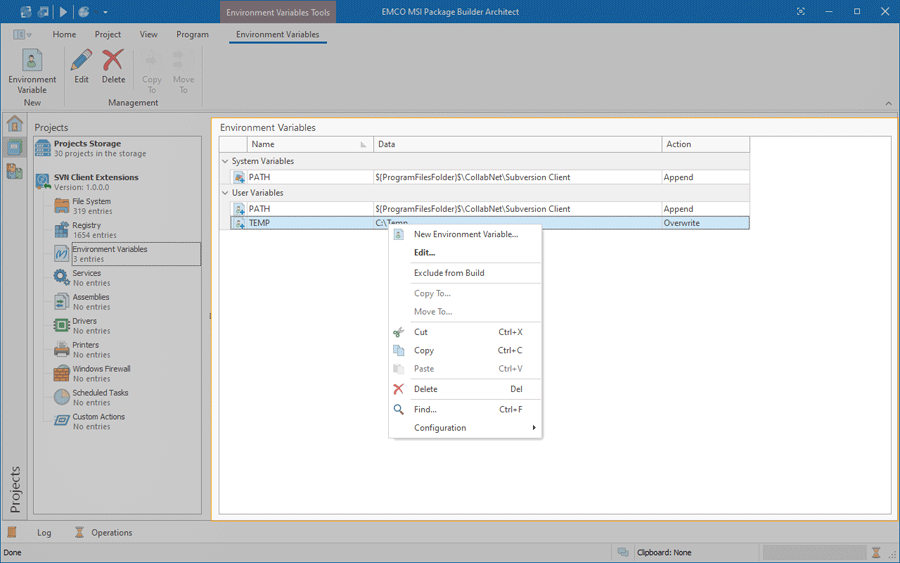Environment Variables View
The Environment Variables view is displayed within the main program area when the Environment Variables node of any project is selected in the Projects view. This view is used to define and review the changes to be performed to the environment variables when installing a deployment package created on a basis of this project Pic 1.
The environment variables modifications can include modifications to user and system variables. When monitoring existing installations, the required changes are created automatically and added to the corresponding project representing the installation process. It is also possible to create the changes manually.
MSIX/AppX packages do not support configuring the environment variables during deployment, so, when generated, those changes are included into MSI and App-V deployment packages only.
The environment variables modifications are by default grouped by the variable type. You can clear the grouping using the table features, and it is possible to revert to the default layout at any time using the Reset Layout item from the configuration menu.
The icon next to every item represented in the Environment Variables view is used to describe of the item's type and state. The state icons are provided to help you understand what is currently happening in the program. You can always see if the item is being processed now by some operation or not.
Below is the list of type icons used:
|
- |
a user environment variable; |
|
- |
a system environment variable; |
The following overlays are used to represent the operation to be performed with each variable when installing a generated deployment package:
|
- |
a variable should be created; |
|
- |
a variable should be created, if it does not exist; |
|
- |
a variable should be removed; |
|
- |
a variable should be removed, if its value matches the defined value; |
|
- |
a variable is excluded from the build. |
The actions for adding, editing and deleting the changes to environment variables as well as copying and moving those changes between projects are available in the Environment Variables view pop-up menu and on the contextual Environment Variables Ribbon page.
Functions Overview
Changes Management |
From the Environment Variables view, you can create, edit and delete the modifications to be performed by a deployment package to the environment variables. The New Environment Variable item from the Environment Variables view pop-up menu as well as the Environment Variable button from the New group on the contextual Environment Variables Ribbon page can be used to create a new modification to environment variables. It is possible to create a new variable, append/prepend data to existing variables and remove variables together with a deployment package deployment process. To change any environment variables modification, you can use the Edit item from the pop-up menu or the Edit button from the Management group on the contextual Environment Variables Ribbon page, and to delete the modification, use the Delete items. |
Copy/Move |
You can easily copy and/or move the modifications to be performed by a deployment package to the environment variables from the Environment Variables view. You can use the drag/drop and copy/paste techniques as well as the Cut, Copy and Paste menu items to reach the goal. It is also possible to use the Copy To and Move To items available both in the pop-up menu and on the contextual Environment Variables Ribbon page to perform copy/move immediately choosing a target project in a dialog. |
Search |
Within the Environment Variables view, you can execute a search for specific changes to the environment variables performed by a deployment package using the Find item from the pop-up menu. |
For detailed information about the changes to environment variables that can be defined in a project refer to the Environment Variables Modifications section of this document.






